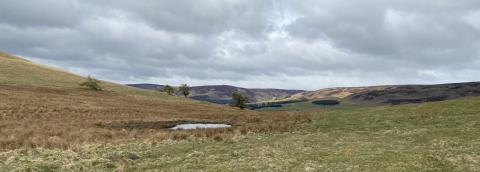The relationship between wetlands and livestock farming is complex and a subject of growing importance in the face of climate change and biodiversity loss. If the relationship is properly managed, there is significant potential to conserve wetlands as an ecosystem while also utilising them for sustainable food production.
We delve into how grazing livestock can promote biodiversity while highlighting the challenges that can arise in animal health due to wetland areas. We hear from Paddy Tarbuck, Sustainability Manager and Dr Bethan John, Animal Health Officer at CIEL, one of the Agri-Tech Centres, and Dr Philip Skuce, Principal Scientist at Moredun Research Institute who discuss the topic.
What are wetlands?
Wetlands are critical yet often overlooked ecosystems within our agricultural landscapes, that play a multifaceted role in sustainable farming practices. They are defined as land areas seasonally or permanently saturated with water, that support a broad range of species that are adapted to live there. Wetlands come in all shapes and sizes, including peatlands, marshes, bogs, and coastal areas.
Historically, wetlands have been undervalued, particularly in agricultural settings, and therefore not protected, leading to significant loss both in terms of area and associated biodiversity – a trend that needs re-evaluation.
Mr Tarbuck adds: “In the UK, despite occupying only 3% of the land, wetlands support a staggering 10% of our/its biodiversity[1].
“Globally, wetlands are pivotal in mitigating climate change, with peatlands storing double the carbon of all the world’s forests, despite covering only 3% of global land mass[2] .
“In the UK, we have lost 90% of our wetland habitats over the past century, raising critical questions.
“However, there is potential to better manage wetlands for the benefits of both the ecosystem and food production,” he says.
The ecosystem of wetlands
Wetlands serves as a crucial habitat for nearly half of the world’s plant and animal species,
Mr Tarbuck adds: “The ecological significance of wetlands is immense.
“Wetlands are not just biodiversity havens: they play a key role in carbon storage, and in climate change mitigation.
“Beyond carbon, wetlands are instrumental in nitrogen cycling, sediment capture, water purification and contributing to the health of our planet.
“They also optimise flood risk management, acting as natural buffers against extreme weather events, which are becoming increasingly frequent due to climate change,” he says.
Therefore, it’s crucial that they are protected and properly utilised in livestock farming.
Grazing livestock can be very effective ecosystem engineers.
Dr Skuce adds: “They can help open up habitats, fertilise the soil, selectively graze to allow rare plant species to thrive and keep sward height down to promote invertebrate biodiversity, which provides an important food source for wetland birds.”
Animal health and wetlands in farm systems
Integrating wetlands into livestock farming systems is a complex yet vital task. While these ecosystems offer significant benefits, they also potentially pose unique challenges in terms of animal health.
Dr John adds: “The presence of wetlands on farms can increase the risk of certain diseases, most notably, liver fluke disease, caused by a nasty flatworm parasite, which favours wetland habitats, because it has a mud snail intermediate host . The liver fluke parasite can cause significant disease and production losses in grazing sheep and cattle.
“The impact of climate change exacerbates disease risks from wetlands, as changing weather patterns can alter the habitats and the distribution of parasites, hosts and vectors.
“Understanding and managing these disease risks, in the context of changing climate conditions, is crucial for maintaining the resilience of food production systems in the UK and beyond,” she says.
Dr Skuce, recommends a proactive, informed and integrated approach to managing livestock health on wetlands, incorporating early detection, targeted intervention, and adapting management to changing environmental conditions.
“It is possible to include livestock in conservation grazing of wetland areas, with all the potential benefits that brings to the livestock and the environment, but this must be carried out in a managed and evidence-based manner.
“Regularly monitoring the health of livestock to detect diseases early, especially those prevalent in wetland areas like liver fluke and implementing quarantine measures for new or incoming livestock is key,” he says.
Adopting targeted treatment approaches for diseases, guided by diagnostic results, will also help towards more responsible use of veterinary medicines, which is also good for the environment.
A balanced approach to wetland management
Finding a balanced approach to wetland management that aligns with the principles of climate smart farming, will be key for protecting wetlands and to allow livestock farmers to produce more sustainably.
This involves not just conserving wetlands but integrating them into farming practices in a way that respects their ecological functions while recognising their potential risks and unintended consequences.
Mr Tarbuck explains how wetland management should be place-based and context-specific, considering the local ecosystems, climate conditions, and farming practices.
“Collaborative efforts among farmers, conservationists, and policymakers are essential to develop strategies that enhance the health of both livestock and wetlands,” he says.
“This integrated approach can contribute significantly to climate change mitigation, biodiversity conservation, and the sustainable future of agriculture.
[1] https://consult.environment-agency.gov.uk/++preview++/environment-and-business/challenges-and-choices/user_uploads/biodiversity-challenge-rbmp-2021.pdf
[2] https://www.iucn-uk-peatlandprogramme.org/about-peatlands


